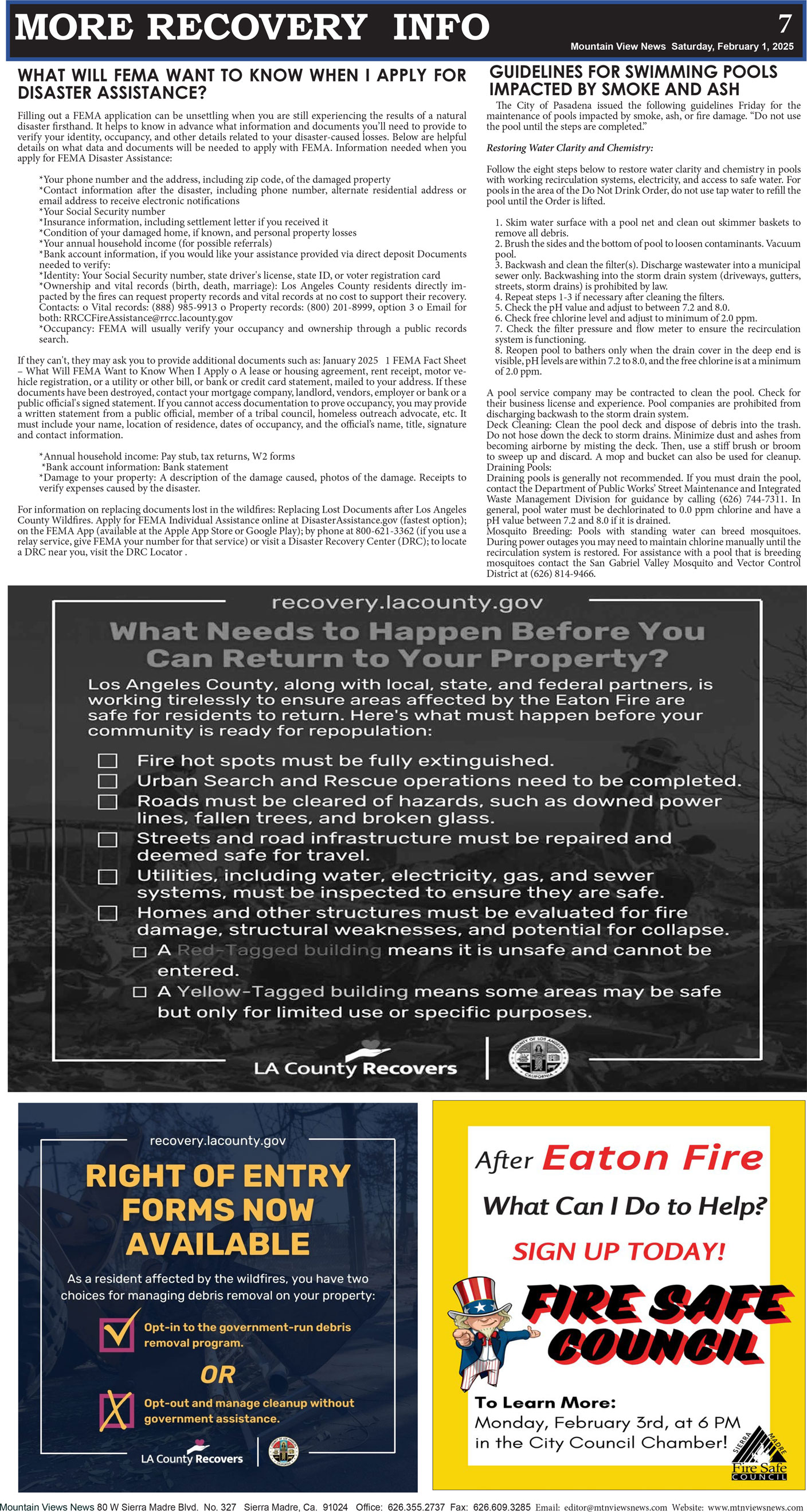
7
MORE RECOVERY INFO
Mountain View News Saturday, February 1, 2025
GUIDELINES FOR SWIMMING POOLS
IMPACTED BY SMOKE AND ASH
WHAT WILL FEMA WANT TO KNOW WHEN I APPLY FOR
DISASTER ASSISTANCE?
Filling out a FEMA application can be unsettling when you are still experiencing the results of a natural
disaster firsthand. It helps to know in advance what information and documents you’ll need to provide to
verify your identity, occupancy, and other details related to your disaster-caused losses. Below are helpful
details on what data and documents will be needed to apply with FEMA. Information needed when you
apply for FEMA Disaster Assistance:
*Your phone number and the address, including zip code, of the damaged property
*Contact information after the disaster, including phone number, alternate residential address or
email address to receive electronic notifications
*Your Social Security number
*Insurance information, including settlement letter if you received it
*Condition of your damaged home, if known, and personal property losses
*Your annual household income (for possible referrals)
*Bank account information, if you would like your assistance provided via direct deposit Documents
needed to verify:
*Identity: Your Social Security number, state driver's license, state ID, or voter registration card
*Ownership and vital records (birth, death, marriage): Los Angeles County residents directly impacted
by the fires can request property records and vital records at no cost to support their recovery.
Contacts: o Vital records: (888) 985-9913 o Property records: (800) 201-8999, option 3 o Email for
both: RRCCFireAssistance@rrcc.lacounty.gov
*Occupancy: FEMA will usually verify your occupancy and ownership through a public records
search.
If they can't, they may ask you to provide additional documents such as: January 2025 1 FEMA Fact Sheet
–What Will FEMA Want to Know When I Apply o A lease or housing agreement, rent receipt, motor vehicle
registration, or a utility or other bill, or bank or credit card statement, mailed to your address. If these
documents have been destroyed, contact your mortgage company, landlord, vendors, employer or bank or a
public official's signed statement. If you cannot access documentation to prove occupancy, you may provide
a written statement from a public official, member of a tribal council, homeless outreach advocate, etc. It
must include your name, location of residence, dates of occupancy, and the official’s name, title, signature
and contact information.
*Annual household income: Pay stub, tax returns, W2 forms
*Bank account information: Bank statement
*Damage to your property: A description of the damage caused, photos of the damage. Receipts to
verify expenses caused by the disaster.
For information on replacing documents lost in the wildfires: Replacing Lost Documents after Los Angeles
County Wildfires. Apply for FEMA Individual Assistance online at DisasterAssistance.gov (fastest option);
on the FEMA App (available at the Apple App Store or Google Play); by phone at 800-621-3362 (if you use a
relay service, give FEMA your number for that service) or visit a Disaster Recovery Center (DRC); to locate
a DRC near you, visit the DRC Locator .
The City of Pasadena issued the following guidelines Friday for the
maintenance of pools impacted by smoke, ash, or fire damage. “Do not use
the pool until the steps are completed.”
Restoring Water Clarity and Chemistry:
Follow the eight steps below to restore water clarity and chemistry in pools
with working recirculation systems, electricity, and access to safe water. For
pools in the area of the Do Not Drink Order, do not use tap water to refill the
pool until the Order is lifted.
1.Skim water surface with a pool net and clean out skimmer baskets to
remove all debris.
2. Brush the sides and the bottom of pool to loosen contaminants. Vacuum
pool.
3.Backwash and clean the filter(s). Discharge wastewater into a municipal
sewer only. Backwashing into the storm drain system (driveways, gutters,
streets, storm drains) is prohibited by law.
4.Repeat steps 1-3 if necessary after cleaning the filters.
5.Check the pH value and adjust to between 7.2 and 8.0.
6.Check free chlorine level and adjust to minimum of 2.0 ppm.
7.Check the filter pressure and flow meter to ensure the recirculation
system is functioning.
8.Reopen pool to bathers only when the drain cover in the deep end is
visible, pH levels are within 7.2 to 8.0, and the free chlorine is at a minimum
of 2.0 ppm.
A pool service company may be contracted to clean the pool. Check for
their business license and experience. Pool companies are prohibited from
discharging backwash to the storm drain system.
Deck Cleaning: Clean the pool deck and dispose of debris into the trash.
Do not hose down the deck to storm drains. Minimize dust and ashes from
becoming airborne by misting the deck. Then, use a stiff brush or broom
to sweep up and discard. A mop and bucket can also be used for cleanup.
Draining Pools:
Draining pools is generally not recommended. If you must drain the pool,
contact the Department of Public Works’ Street Maintenance and Integrated
Waste Management Division for guidance by calling (626) 744-7311. In
general, pool water must be dechlorinated to 0.0 ppm chlorine and have a
pH value between 7.2 and 8.0 if it is drained.
Mosquito Breeding: Pools with standing water can breed mosquitoes.
During power outages you may need to maintain chlorine manually until the
recirculation system is restored. For assistance with a pool that is breeding
mosquitoes contact the San Gabriel Valley Mosquito and Vector Control
District at (626) 814-9466.
Mountain Views News 80 W Sierra Madre Blvd. No. 327 Sierra Madre, Ca. 91024 Office: 626.355.2737 Fax: 626.609.3285 Email: editor@mtnviewsnews.com Website: www.mtnviewsnews.com
|